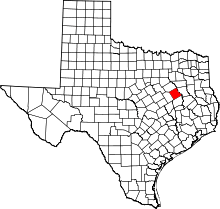Wortham, Texas
| Wortham, Texas | |
|---|---|
| Town | |
|
Location of Wortham, Texas | |
 | |
| Coordinates: 31°47′18″N 96°27′44″W / 31.78833°N 96.46222°WCoordinates: 31°47′18″N 96°27′44″W / 31.78833°N 96.46222°W | |
| Country | United States |
| State | Texas |
| County | Freestone |
| Area | |
| • Total | 2.0 sq mi (5.1 km2) |
| • Land | 2.0 sq mi (5.1 km2) |
| • Water | 0.0 sq mi (0.0 km2) |
| Elevation | 476 ft (145 m) |
| Population (2010) | |
| • Total | 1,073 |
| • Density | 540/sq mi (208.5/km2) |
| Time zone | Central (CST) (UTC-6) |
| • Summer (DST) | CDT (UTC-5) |
| ZIP code | 76693 |
| Area code(s) | 254 |
| FIPS code | 48-80296[1] |
| GNIS feature ID | 1350596[2] |
Wortham is a town in Freestone County, Texas, United States. The population was 1,073 at the 2010 census.[3]
Geography
Wortham is located in the northwest corner of Freestone County at 31°47′18″N 96°27′44″W / 31.78833°N 96.46222°W (31.788472, -96.462209).[4] Texas State Highway 14 runs through town as Third Street, leading north 10 miles (16 km) to Richland and Interstate 45, and south 8 miles (13 km) to Mexia. Fairfield, the Freestone County seat, is 18 miles (29 km) to the southeast.
According to the United States Census Bureau, the town has a total area of 2.0 square miles (5.1 km2), all of it land.[3] Wortham lies near the highest point between Dallas and Houston, the nearby Tehuacana Hills.
History
Wortham is situated on a grant given in 1834 by Mexico to Robert B. Longbotham (born December 29, 1797[5]), an immigrant from England who settled there in 1839. In 1871, when the Houston and Texas Central Railway was planned through the area, Longbotham sold the right of way for five dollars. A townsite was purchased from Longbotham by a group of investors, who platted a town named "Tehuacana". When a post office was established in November 1871, however, the name was changed to "Long Bottom", a corruption of the original owner's name. In 1874 the settlement was renamed "Wortham" in honor of Col. Rice Wortham, a merchant who had been instrumental in convincing the railroad to build through the area.
In 1885 Wortham was a small market center for area cotton farmers, with several churches, steam, grist, and corn mills, cotton gins, a general store, and about thirty inhabitants. During the 1890s the town experienced rapid growth. It incorporated in 1910, and by 1914 it had a cottonseed-oil mill, three cotton gins, two banks, a weekly newspaper, the Wortham Journal, and a population of 950. Wortham remained a small market center until 1924, when oil was discovered in the Wortham field. As early as 1912 C. L. Witherspoon, hired by the city to drill a water well, struck a pocket of natural gas. Between 1919 and 1923 oil exploration began in the area, and on November 27, 1924, the Roy Simmons No. 1 well came in as a gusher. Within three weeks more than 300 drilling rigs were in the field. In January 1925 alone more than 3,500,000 barrels (560,000 m3) of oil were produced, and the total for the year of 1925 was 16,838,150 barrels (2,677,052 m3).
The town of Wortham was transformed overnight. The population rose from 1,000 to some 35,000 at the height of the boom in 1925. Housing and the town's infrastructure were completely inadequate, and law enforcement officials had great difficulty controlling the rowdy oilfield workers. Intensive drilling brought the boom to an end by late 1927, and by 1929 the population had dropped to around 2,000. The onset of the Great Depression, plummeting cotton prices, and the end of the oil boom combined to bring hard times for Wortham. Then on April 9, 1932, an earthquake rattled the town in the early morning hours, destroying chimneys and damaging other structures. The number of businesses dropped from seventy-two in 1931 to fifty in 1936. After World War II, the decline continued, and by the early 1980s only sixteen rated businesses remained. The town also witnessed a slow population decline during the same period, falling to low of about 1,000 in 1975. Since the mid-1980s, however, the population has been steadily growing, and in 1990 Wortham had 1,020 residents and fifteen businesses. The population was 1,082 in 2000.
Demographics
| Historical population | |||
|---|---|---|---|
| Census | Pop. | %± | |
| 1880 | 245 | — | |
| 1890 | 401 | 63.7% | |
| 1910 | 899 | — | |
| 1920 | 1,100 | 22.4% | |
| 1930 | 1,404 | 27.6% | |
| 1940 | 1,267 | −9.8% | |
| 1950 | 1,170 | −7.7% | |
| 1960 | 1,087 | −7.1% | |
| 1970 | 1,036 | −4.7% | |
| 1980 | 1,187 | 14.6% | |
| 1990 | 1,020 | −14.1% | |
| 2000 | 1,082 | 6.1% | |
| 2010 | 1,073 | −0.8% | |
| Est. 2015 | 1,028 | [6] | −4.2% |
As of the census[1] of 2000, there were 1,082 people, 428 households, and 278 families residing in the town. The population density was 545.9 people per square mile (211.0/km²). There were 479 housing units at an average density of 241.7 per square mile (93.4/km²). The racial makeup of the town was 79.94% White, 17.84% African American, 0.65% Native American, 1.20% from other races, and 0.37% from two or more races. Hispanic or Latino of any race were 2.77% of the population.
There were 428 households out of which 35.0% had children under the age of 18 living with them, 46.3% were married couples living together, 15.7% had a female householder with no husband present, and 35.0% were non-families. 32.0% of all households were made up of individuals and 17.5% had someone living alone who was 65 years of age or older. The average household size was 2.45 and the average family size was 3.12.
In the town the population was spread out with 28.4% under the age of 18, 7.1% from 18 to 24, 25.8% from 25 to 44, 20.4% from 45 to 64, and 18.3% who were 65 years of age or older. The median age was 36 years. For every 100 females there were 80.6 males. For every 100 females age 18 and over, there were 72.2 males.
The median income for a household in the town was $23,988, and the median income for a family was $35,625. Males had a median income of $26,094 versus $18,098 for females. The per capita income for the town was $14,269. About 14.7% of families and 18.1% of the population were below the poverty line, including 22.1% of those under age 18 and 17.1% of those age 65 or over.
Education
The town is served by the Wortham Independent School District and is home to the Wortham High School Bulldogs.
Notable people
- Leonard Davis, a guard/offensive tackle for the Dallas Cowboys and Detroit Lions
- Blind Lemon Jefferson, an influential blues musician, born and buried in Wortham
References
- 1 2 "American FactFinder". United States Census Bureau. Retrieved 2008-01-31.
- ↑ "US Board on Geographic Names". United States Geological Survey. 2007-10-25. Retrieved 2008-01-31.
- 1 2 "Geographic Identifiers: 2010 Demographic Profile Data (G001): Wortham town, Texas". U.S. Census Bureau, American Factfinder. Retrieved September 7, 2016.
- ↑ "US Gazetteer files: 2010, 2000, and 1990". United States Census Bureau. 2011-02-12. Retrieved 2011-04-23.
- ↑ A Memorial and Biographical History of Navarro, Henderson, Anderson, Limestone, Freestone and Leon Counties, Texas. Chicago: Lewis Publishing Company. 1893. p. 423. Retrieved 28 September 2014.
- ↑ "Annual Estimates of the Resident Population for Incorporated Places: April 1, 2010 to July 1, 2015". Retrieved July 2, 2016.
- ↑ "Census of Population and Housing". Census.gov. Retrieved June 4, 2015.
